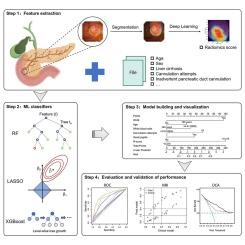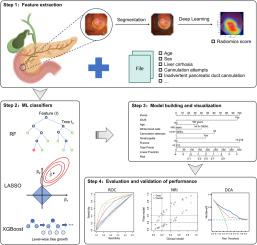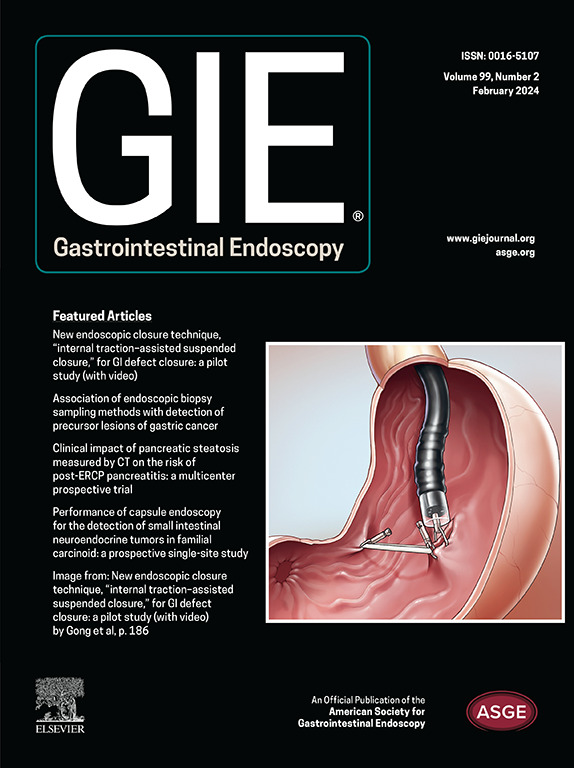基于十二指肠乳头放射组学的内镜逆行胰胆管造影术后胰腺炎机器学习预测模型:一项回顾性多队列研究。
IF 6.7
1区 医学
Q1 GASTROENTEROLOGY & HEPATOLOGY
引用次数: 0
摘要
背景和目的十二指肠乳头是ERCP的主要和必要途径,在很大程度上决定了ERCP的复杂性和结果。我们研究了乳头形态与ERCP术后胰腺炎(PEP)之间的关联,并构建了一个预测PEP的稳健模型。方法我们回顾性地纳入了2019年1月至2022年6月在2个中心接受ERCP的患者。通过深度学习从内窥镜图像中提取乳头的放射学特征。使用 3 种机器学习算法评估了潜在的预测因素及其重要性。结果来自 2 个中心的 2038 名和 334 名 ERCP 患者参加了这项研究,PEP 率分别为 7.9% 和 9.6%。放射学评分与 PEP 显著相关,并显示出很高的诊断价值(AUC,.755-.821)。我们选择了六个枢纽预测因子来建立预测模型。基于放射组学的模型在训练组、测试组和验证组中表现出了极好的辨别能力(AUC,0.825-0.857)和治疗效果。加入放射组学评分后,预测模型的诊断准确性明显提高(净再分类提高,0.151-.583 [P < .05];综合辨别提高,0.097-.235 [P < .001])。基于乳头放射组学的模型在临床预测 PEP 方面表现良好。本文章由计算机程序翻译,如有差异,请以英文原文为准。


Duodenal papilla radiomics-based prediction model for post-ERCP pancreatitis using machine learning: a retrospective multicohort study
Background and Aims
The duodenal papillae are the primary and essential pathway for ERCP, greatly determining its complexity and outcome. We investigated the association between papilla morphology and post-ERCP pancreatitis (PEP) and constructed a robust model for PEP prediction.
Methods
We retrospectively enrolled patients who underwent ERCP in 2 centers from January 2019 to June 2022. Radiomic features of the papilla were extracted from endoscopic images with deep learning. Potential predictors and their importance were evaluated with 3 machine learning algorithms. A predictive model was developed using best subset selection by logistic regression, and its performance was evaluated in terms of discrimination, calibration, and clinical utility based on the area under curve (AUC) of the receiver-operating characteristic curve, calibration curve, and clinical decision curve, respectively.
Results
From 2 centers, 2038 and 334 ERCP patients were enrolled in this study with PEP rates of 7.9% and 9.6%, respectively. The radiomic score was significantly associated with PEP and showed great diagnostic value (AUC, .755-.821). Six hub predictors were selected to conduct a predictive model. The radiomics-based model demonstrated excellent discrimination (AUC, .825-.857) and therapeutic benefits in the training, testing, and validation cohorts. The addition of the radiomic score significantly improved the diagnostic accuracy of the predictive model (net reclassification improvement, .151-.583 [P < .05]; integrated discrimination improvement, .097-.235 [P < .001]).
Conclusions
The radiomic signature of the papilla is a crucial independent predictor of PEP. The papilla radiomics-based model performs well for the clinical prediction of PEP.
求助全文
通过发布文献求助,成功后即可免费获取论文全文。
去求助
来源期刊

Gastrointestinal endoscopy
医学-胃肠肝病学
CiteScore
10.30
自引率
7.80%
发文量
1441
审稿时长
38 days
期刊介绍:
Gastrointestinal Endoscopy is a journal publishing original, peer-reviewed articles on endoscopic procedures for studying, diagnosing, and treating digestive diseases. It covers outcomes research, prospective studies, and controlled trials of new endoscopic instruments and treatment methods. The online features include full-text articles, video and audio clips, and MEDLINE links. The journal serves as an international forum for the latest developments in the specialty, offering challenging reports from authorities worldwide. It also publishes abstracts of significant articles from other clinical publications, accompanied by expert commentaries.
 求助内容:
求助内容: 应助结果提醒方式:
应助结果提醒方式:


